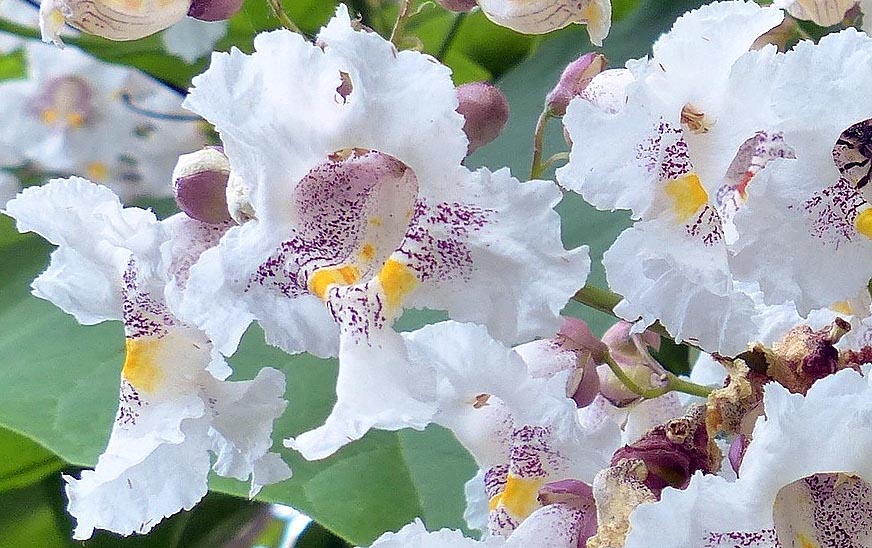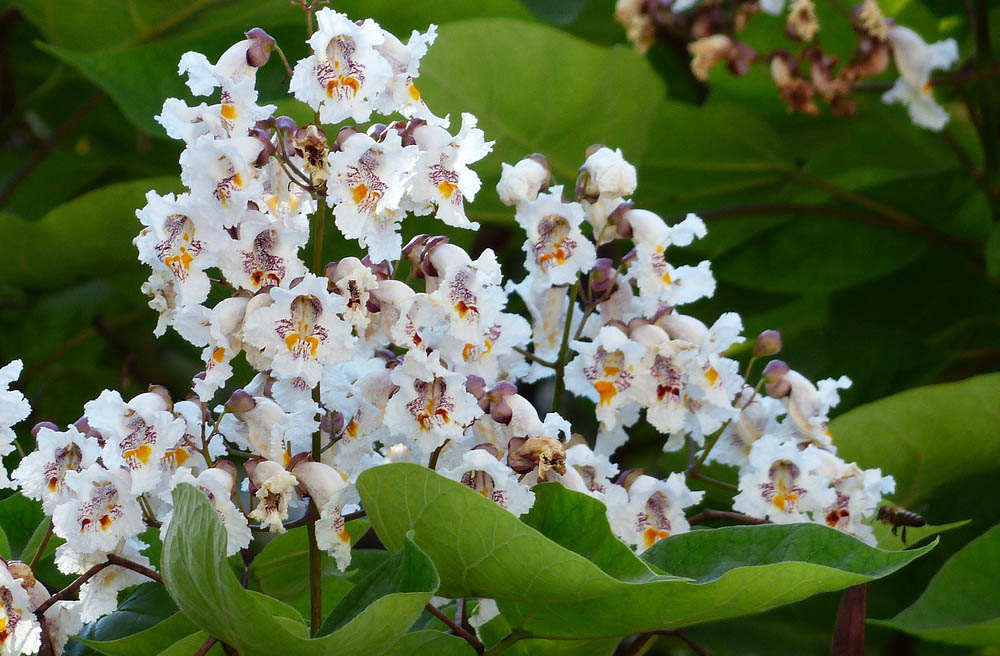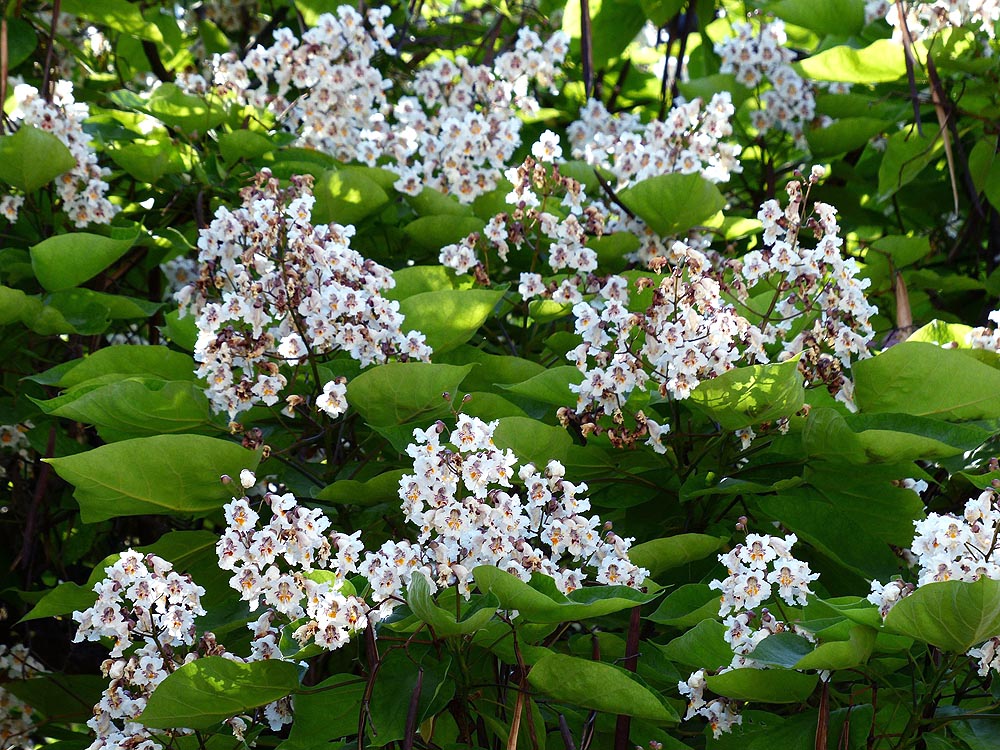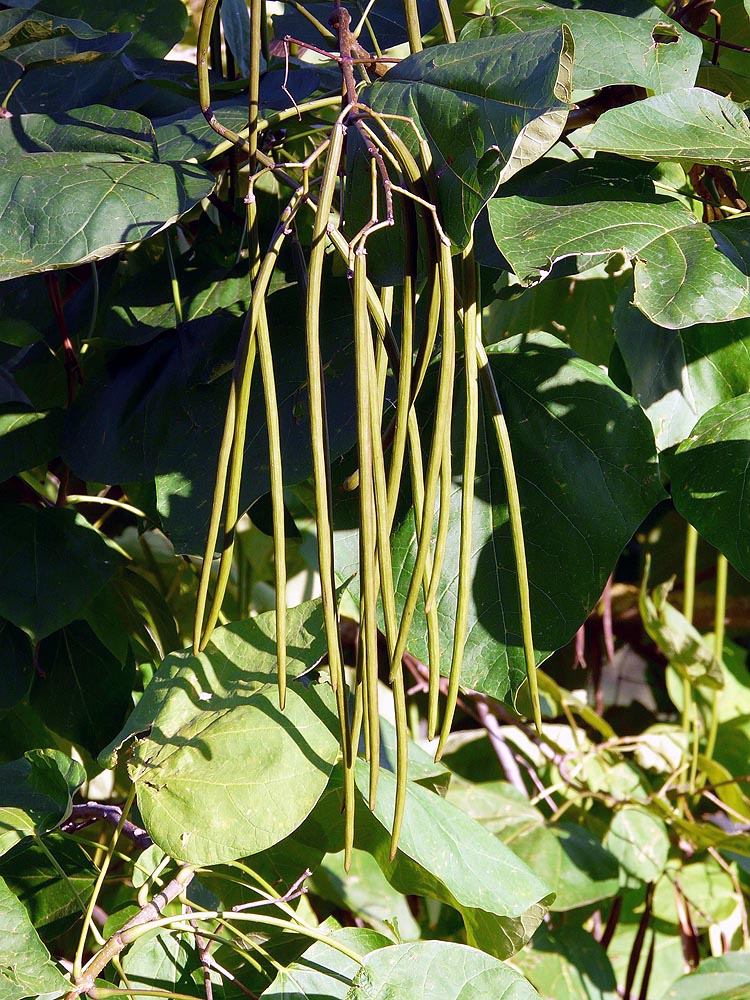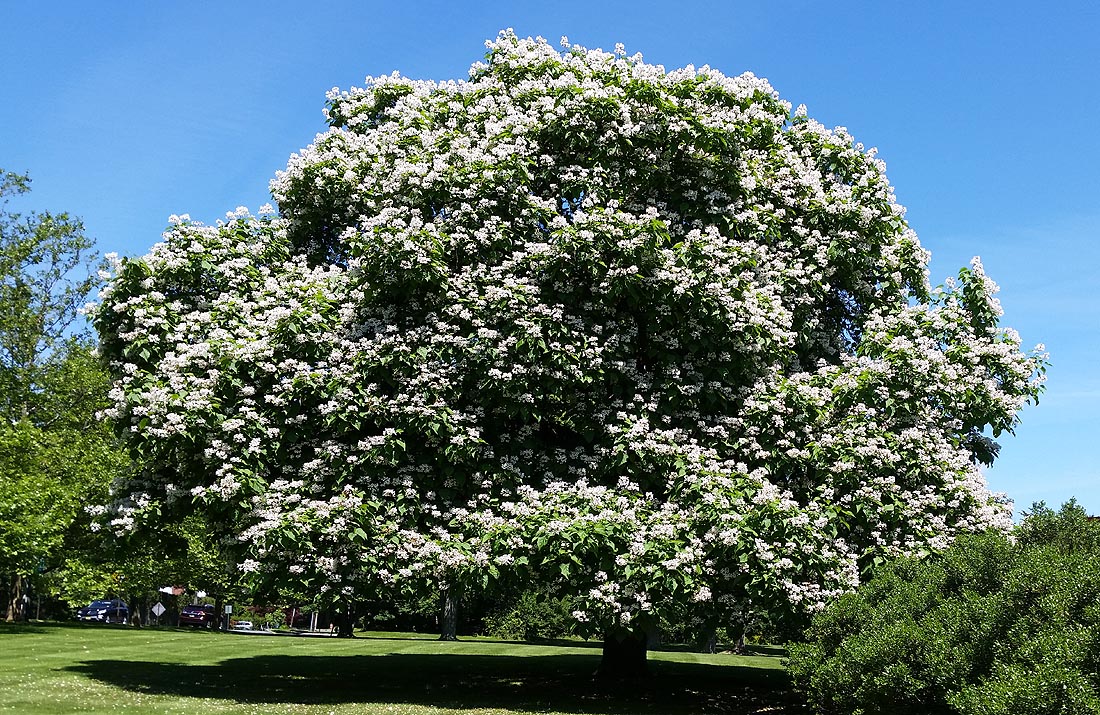The most beautiful flowering Native American tree. The huge clusters of exotic orchid like flowers that cloak the tree in springtime make this a magnificent tree. These are followed by very large green heart shaped leaves that make the tree look more tropical and exotic but its hardy to zone 4! The super long green seed pods have given the tree the common name of bean tree, or runner bean tree. The long needle like pods cover the tree in late summer before turning brown but they can remain on the tree well into winter. Given sufficient room this tree will grow with a lovely pyramid shape making it a wonderful shade tree for the larger garden. Its very easy to grow from seed flowering from seed in about 7 years but even young trees have an exotic look to them.
In mid spring the flowers appear before the leaves. They are large very orchid-like and often completely cover the tree making it look extremely exotic and beautiful. Flowers occur in clusters on last years wood, they are tubular up to 2.5 inches ( 3.2cm) long and an inch (2.5cm) wide. They are white with five ruffled lobes that have purple spots and streaks leading into the tube. The lower three lobes are longer than the upper ones and have a pair of golden orange patches that extend into the flower tube. All the petals curve outwards displaying the flower center with 5 stamens only 2 of which are fertile and surround the style. Flowers occur in large open clusters with each separated by longish stalks.
After the flowers come the showy seed pods. These are long and narrow up to 20 inches (50.8cm) in length and about 0.5- 0.75 inches (1.2-2 cm) wide and are very reminiscent of a green bean. they remain green most of the summer only turning brown as the seed ripen in the autumn. The often remain on the tree throughout the winter only falling in spring before the flowers appear. Then the pod splits in to revealing flat seeds with a papery covering that overlap within the pod each seed with its covering is about 1 inch (2.54cm) long.
The large catalpa leaves can turn dull yellow or brown in autumn they are often still green when they fall from the tree.
mature trees offer great shade due to their large leaves and can grow to 70 feet (21m) in height and spreading to 50 feet (15m) across . They are hardy to zone 4 and will grow in zone 8.
Plant seeds in good well draining compost in individual pots covering the seeds with about 0.5-0.75 inches (1.27-1.8cm) of soil and keep moist. Seeds usually germinate in 4-8 weeks but it will depend on growing conditions. Once the seeds germinate keep the lightly watered and encourage them to grow. As they grow repot into larger and larger pots. It is best to keep seedlings in pots for at least the first year before planting out to ensure they are not overrun by weeds or eaten by wildlife who often love your trees. Once the trees reach 18 inches (45.7cm) plant out in desired location.
NOTE. When growing trees ensure you are using deep pots. Trees produce long tap roots that need space to grow most pots are not long enough to grow tree in. You can purchase 'tree pots' or create your own by duck taping two pots together (after you have removed the bottom of one pot).
When planting out check the roots before planting. If roots have circled the pot and become pot bound they need to be pruned out. Using long pots helps prevent this. Any root that has circled the pot must be removed before planting. If left such roots can continue to circle the plant as they grow it can strangle the tree and kill it. This is known as a girdling root.
If trees have not reached the desired height to be planted out in the first year they will need to remain in pots over the winter. Protect pots from freezing the roots, while roots freeze in the ground they have all the soil around them to protect them. In small pots the roots can become damaged so keep them where they are more protected.
This can be done in several ways. First place them in a cold greenhouse or cold frame for the winter. If none is available pots can be buried in thick piles of mulch allow at least 6 inches ( 15.24cm) between pots and pack tightly with mulch.
The simplest method is to dig a small trench in the autumn and place the pots in it, then fill in the soil around them and leave until spring. Space pots at least 6 inches ( 15.24cm) apart, more if the pots are larger. For more details see our Growing Trees from Seeds article.
For the best trees full sun is required, they are not to fussy bout soil type provided it is well drained and will grow on almost anything. See the photo above with small trees growing out of piles of discarded asphalt. Catalpas can also tolerate salty soils but will not do well directly on the coastline since while the roots may survive the salt the leaves do not do as well. They wont tolerate wet or waterlogged soils.
Place a layer of mulch around the base of the trees to keep down weeds and help feed the tree a slow release fertilizer under young trees in spring will aid their growth.
As long as your location gets rainfall there should be no need to water your tree unless there is a severe drought.
Care should be taken when planting near waterways as the trees like the moisture on the stream banks and seeds can spread and become invasive. Seeds will germinate readily in most areas just like any other tree, most seedlings can be controlled or mowed down but near waterways the seeds can travel in the streams and begin growing far from the original tree.
If the infestation is large they can defoliate a mature tree in a matter of weeks. Grab and vigorously shake the branches to dislodge the insects. Then remove the larva. If you have chickens allow them to roam under the tree while it is being shaken they will quickly gobble up the larva, or they can be collected and dried for later chicken treats.
Other pests include aphids, mealybugs and Japanese beetles but these don't do as much damage as the moth. Powdery mildew can also effect the trees but its only common in warmer more humid climates.
Thus we can suggest that the bark of this tree is also has the same mild narcotic action and sedative effect which leads to its use in treatment of asthma, whooping cough and spasmodic coughing especially in children. The bark made into a tea or decoction is used as a laxative, antiseptic and antidote to snake bites, although which snakes are not stated. It has been used as a treatment for malaria as a substitute for quinine. The leaves are used as a poultice on wounds and abrasions.






